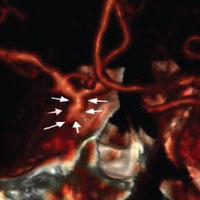Contrast-enhanced encephalopathy and massive cerebral edema after endovascular coiling of cerebral aneurysm. A case report

HTML: 3
All claims expressed in this article are solely those of the authors and do not necessarily represent those of their affiliated organizations, or those of the publisher, the editors and the reviewers. Any product that may be evaluated in this article or claim that may be made by its manufacturer is not guaranteed or endorsed by the publisher.
Authors
Contrast-induced encephalopathy (CIEP) is a rare complication after endovascular therapy. The etiology of CIEP is still a matter of debate. We present a rare occurrence of CIEP in a known hypertensive and type 2 diabetic patient after endovascular coiling of cerebral aneurysm with oculomotor nerve palsy. A 68-year old female presented with seven days history of headache and left ptosis or blepharoptosis with mild mydriasis. The headaches were localized mainly at the left side of the nose, orbit, and upper forehead while the left ptosis was associated with blurred vision. Computed tomography angiography revealed an aneurysm in between the C4 segment of the left internal carotid artery (ICA) and the bifurcation of the left posterior communicating artery. Digital subtraction angiography further confirmed the aneurysm. We used the transarterial approach to assess the aneurysm and subsequent coiling. Iohexol (Omnipaque) contrast agent was used during the endovascular procedure. The patient’s condition deteriorated into acute confusion state with cardinal symptomology of CIEP immediately after the operation. Computed tomography scan revealed cortical contrast enhancement in the vascular territory of the ICA as well as edema. Her symptomatology resolved 48 hours after treated with anticonvulsants, intracranial pressure reduction and hydration. Chronic hypertension as well as type 2 diabetics may be critical predisposing factors to CIEP. CIEP should be suspected in patients presenting with acute confusion state after endovascular therapy. Massive edema with ischemic brain changes in white matter of the brain before endovascular procedure should rise suspicion of CIEP.
How to Cite
PAGEPress has chosen to apply the Creative Commons Attribution NonCommercial 4.0 International License (CC BY-NC 4.0) to all manuscripts to be published.

 https://doi.org/10.4081/vl.2021.9767
https://doi.org/10.4081/vl.2021.9767





